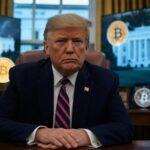Now Reading: Trump’s Pause on ‘Reciprocal’ Tariffs Did Little To Reduce Economic Risks
-
01
Trump’s Pause on ‘Reciprocal’ Tariffs Did Little To Reduce Economic Risks
Trump’s Pause on ‘Reciprocal’ Tariffs Did Little To Reduce Economic Risks

:max_bytes(150000):strip_icc():format(jpeg)/GettyImages-2208898875-dfd20fad08f7474ca431baca7ce2fe2d.jpg)
Key Takeaways
- President Donald Trump paused most of his “reciprocal” tariffs this week, leaving many others in place, as a simmering trade war threatens to be a drag on growth and push up prices.
- A typical household will pay more than $4,000 a year in import taxes even after the pause, one economist estimated.
- The remaining tariffs will drag down economic growth and stoke inflation, potentially leading to “stagflation,” forecasters said.
Financial markets may have rejoiced this week at the 90-day reprieve on President Donald Trump’s “Liberation Day” tariffs, but the U.S. economy still faces a similar outlook as it did before the pause.
Higher consumer prices, slower growth, and an elevated risk of recession are still forecast despite Trump’s withdrawal of the varied ‘reciprocal’ tariffs that the White House announced last week.
The rapid-fire tariff policy changes mean many importers face lower tariffs than initially announced. However, U.S. consumers will still likely pay higher prices for imports than they did a month ago. The remaining tariffs include:
- A 145% tariff on China
- A 10% global tariff
- A 25% tariff on certain products from Canada and Mexico
- A 25% tariff on cars, with a 25% tariff on car parts set to go into effect in May
- A 25% tariff on steel and aluminum
The tariff against China was so extreme it was nearly the same as entirely cutting off trade with the U.S.’s third-largest trading partner, several economists said.
“The average tariff rate currently stands at around 20%, with the tariff rate on China…constituting a de facto embargo,” Preston Caldwell, chief U.S. economist at Morningstar, wrote in a commentary Wednesday. “By comparison, at the end of 2024, the average effective tariff rate was 2.4%.”
The U.S. will buy 90% fewer products from China if the tariffs hold, shifting purchases to other countries, economists at Pantheon Macroeconomics estimated.
Inflation and Recession Still Possible, Forecasters Say
The remaining tariffs will take a significant financial toll on U.S. consumers as well as the economy, forecasters said. Economists at Goldman Sachs rolled back their forecast for a recession in the coming year from 60% before the delay was announced but still saw a 45% chance of a recession.
“What was pulled back yesterday was actually enough for us to change our view about the effect of this on the economy, but ultimately, doesn’t change the fact that you still got a substantial tariff rate,” Alec Phillips, chief U.S. political economist at the investment bank, said in a conference call with clients Thursday.
Other forecasters said the 90-day reprieve had not nearly reversed the damage.
“It was encouraging to see the president reverse himself on the so-called ‘reciprocal’ tariffs yesterday, but I wouldn’t take much solace in it as the global trade war continues to rage. I still put the odds of a recession this year at 60%,” Mark Zandi, chief economist at Morgan Stanley, posted on social media platform X.
Prediction markets were just as pessimistic, with gamblers on Polymarket pricing in about a 60% chance of a recession occurring in 2025.
Economists at the Yale Budget Lab estimated Thursday that the costs of the tariffs will likely be passed through to consumers. The lab revised its estimates in the wake of the pause and found that the typical U.S. household will still lose $4,700 of purchasing power per year.





























